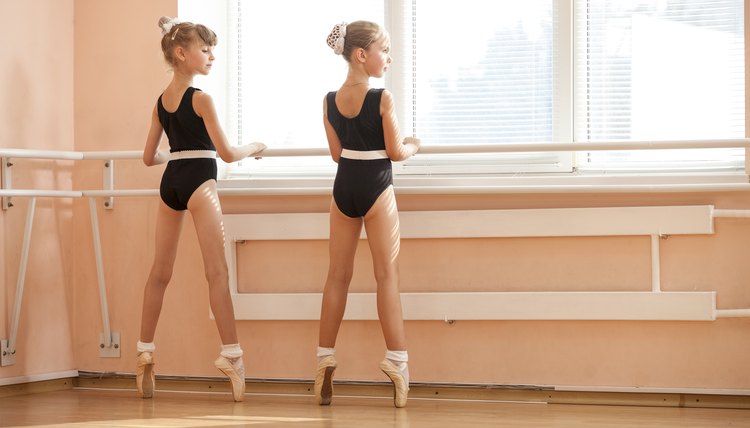A List of Ballet Exercises

Ballet is a challenging form of sport and art. It is demanding in regard to both aesthetic and athletic factors. Ballet is similar to sports that involve non-steady state, intermittent types of activity like gymnastics. Therefore, ballet requires not only muscular strength, but both aerobic and anaerobic capabilities.
Barre Work
All classical ballet classes begin at the barre. The exercises performed at the barre are meant to prepare dancers for what they will later do without support in the center of the floor. Dancers hold on to the barre with one hand (switching sides after each combination) and complete about 10 total combinations before moving on to the center floor work. Barre work exercises are conducted in a specific order, often similar to the following: plies, slow tendus (sometimes with fondu), fast tendus, slow degages, fast degages, ronds de jambe a terre with port de bras, frappes with releves, fondus, ronds de jambe en l'air, adagio, grande battements, and a stretch for the body and legs on the barre. In a 90-minute ballet class, barre work will comprise approximately 45 minutes.
Center Work-Part One

photobac/iStock/Getty Images
Once barre is completed, dancers move into the center of the floor. The exercises completed in the center will vary widely depending on the instructor and level of the students. Exercises executed during an average ballet class will follow an order similar to the following: adagio, tendus, fondus with ronds de jambe a terre, pirouettes in center, travelling work from corner to corner (e.g., waltzs, pirouettes, traveling turns like piques, chaines, soutenus). This section of class may take 30 minutes to complete.
Center Work-Part Two
The final part of a ballet class consists of jumping and is the portion of class primarly in which dancers utilize aerobic metabolic pathways. Jumping will begin with a series of small jumps to warm up the feet, ankles, knees, and muscles activated during a jump. Once these are completed, dancers will perform one to two petite allegros (small, quick movements), and medium jump (a bit larger jump to slower music), a traveling jump (such as brise or emboite), and class usually finishes with a grande allegro (largest and slowest jump yet). If time and skill allows, dancers may be asked to perform a series of turns called fouettes. Dancers will jump for about 15 to 20 minutes in a typical ballet class.
References
Writer Bio
Ashley Lucas has been writing since 2005. Her articles have appeared in "PULSE," "Today's Dietitian" and other academic journals. Lucas has a Bachelor of Fine Arts in ballet performance from the University of Utah and a Doctor of Philosophy in sports nutrition and chronic disease from Virginia Tech.
